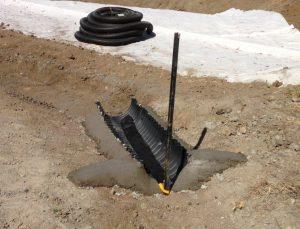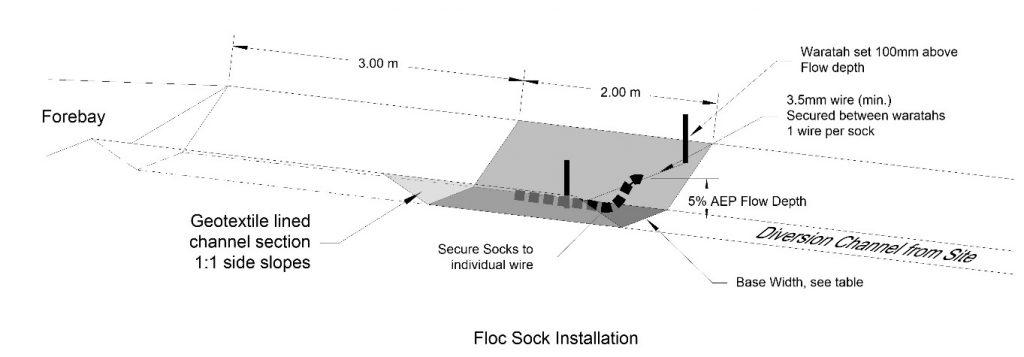Sediment Control
Coagulants and flocculants:
Floc socks
What, why, when, and issues to look out for
What

Dirty water will receive flocculent treatment when it flows across a floc sock in the channel upstream of DEB. Note the concrete wingwalls which ensure that the floc sock is not outflanked.
A floc sock is a segmented, geosynthetic sock filled with reagent in dry flake form. You put it in the dirty water diversion channel, so that dirty water runoff flows over it, dissolving and mixing with the reagent.
Why
Floc sock treatment is generally used for smaller catchments or for short durations when it is not appropriate to establish a rainfall-activated system.
When
Floc socks are mainly used in the following situations:
- The treatment is for a short time (up to 4 weeks), or
- The catchment area is smaller than 0.5 ha.
Issues to look out for
Floc socks have the following limitations. They are generally not appropriate for:
- Long-term duration works (greater than 1 month)
- Large catchments (over 0.5 ha)
- Earthwork areas during periods of increased rainfall (eg winter)
- Sites that are unattended for more than 48 hours
- Where precise dosing is required to achieve acceptable water quality.
Design essentials
Floc socks can contain different reagents. Identify one that:
- Will make a noticeable improvement in sediment retention for your site
- Is not badly affected by over- or under-dosing
- Does not result in significant changes to pH as a result of over- or under-dosing.
Determine the volume of water that each sock is able to treat, so you install the correct number of socks to treat runoff from a 50 mm rainfall event.
Construction, operation and maintenance
When constructing floc socks
- Only implement this treatment under the supervision of a suitably experienced and qualified professional.
- To provide the correct dosing, lay the appropriate number of floc socks in the diversion drains approximately 5 m upstream of the forebay of the DEB.
- Flows need maximum contact with the socks. Place the socks in a defined channel, so that they come into contact with the full flow depth for all rainfall events up to and including the 5% AEP event (maximum flow diverted by the diversion bunds).
- Follow the installation guidance in the diagram:
When operating and maintaining floc socks
- Assess the maintenance requirements of the floc sock treatment system before and after every rainfall event, or during exceptionally heavy and/or prolonged rain.
- Check the floc socks regularly to make sure that they remain within the area of maximum channel flow, and are not caked with or covered by accumulated sediment.
- Before leaving the site unattended over weekends or other periods, check that there is enough reagent in the floc socks to control runoff from a 50 mm rainfall event.
